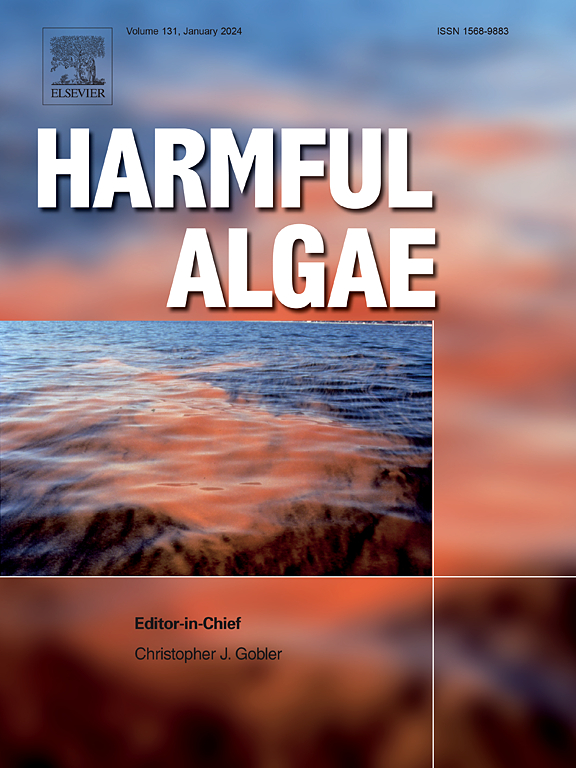在美国纽约州的河口,放牧浮游动物可以促进和控制尖锐尖藻(Dinophysis acuminata)引起的有害藻华的繁殖
IF 4.5
1区 生物学
Q1 MARINE & FRESHWATER BIOLOGY
引用次数: 0
摘要
虽然有研究表明,由嗜酸性混合营养型尖藻(Dinophysis acuminata)引起的有害藻华与纤毛虫(Mesodinium rubrum)有关,但浮游动物的放牧在这些有害藻华发生中的作用仍在研究中。本研究在美国纽约州的两个港口追踪了D. acuminata藻华的动态,为期三年(2019-2021年),在此期间,利用Imaging FlowCytobot (IFCB)对20µm至150µm之间的浮游生物进行了量化,实验评估了本地原生浮游动物和引入的桡足类动物(Acartia tonsa)的放牧情况。在每一年,原始浮游动物对藻华的摄取量在华始期较低,但在华始期超过藻华的细胞生长速率,说明缺乏摄取量有利于华始,但摄取量的开始促进了华始的减少。在14个试验中,有10个试验中,幼虫的添加提高了甲藻的生长速率,其中3个试验中差异显著。这一发现表明,幼桡足类动物可以触发营养级联,潜在地消耗恐龙捕食者,并从食草动物控制中释放出有害藻华。相比之下,成虫和其他中浮游动物对甲藻密度的影响很小,这表明中浮游动物没有直接影响藻华。综上所述,本研究表明,在开花开始时减少放牧压力有利于开花发育,在开花高峰期增加放牧压力有利于开花下降,幼桡足类通过诱导营养级联促进开花。本文章由计算机程序翻译,如有差异,请以英文原文为准。
Zooplankton grazing can facilitate and control the proliferation of harmful algal blooms caused by Dinophysis acuminata in NY, USA, estuaries
While harmful algal blooms (HABs) caused by the obligate-mixotroph, Dinophysis acuminata, have been associated with the ciliate, Mesodinium rubrum, the role of zooplankton grazing in the occurrence of these HABs has been under studied. Here, the dynamics of D. acuminata blooms were tracked within two NY, USA, harbors, over three years (2019–2021) during which grazing by native protozooplankton and introduced copepods (Acartia tonsa) was evaluated experimentally using an Imaging FlowCytobot (IFCB) to quantify plankton between 20 µm and 150µm. During each year, protoozooplankton grazing on Dinophysis was low during the bloom initiation period but exceeded cellular growth rates of Dinophysis during the peak bloom period, suggesting that a lack of grazing permitted bloom initiation but grazing onset facilitated bloom decline. The addition of juvenile Acartia increased Dinophysis growth rates in 10 of 14 experiments with differences being significant during three, bloom peak experiments. This finding suggests juvenile copepods can trigger a trophic cascade, potentially consuming Dinophysis-predators and releasing this HAB from grazer control. In contrast, adult Acartia and other mesozooplankton had minimal effects on Dinophysis densities suggesting that mesozooplankton did not directly impact blooms. Collectively, this study demonstrates that reduced grazing pressure at the onset of blooms facilitates bloom development, enhanced grazing during bloom peak can facilitate bloom decline, and that juvenile copepods can promote blooms via the induction of a trophic cascade.
求助全文
通过发布文献求助,成功后即可免费获取论文全文。
去求助
来源期刊

Harmful Algae
生物-海洋与淡水生物学
CiteScore
12.50
自引率
15.20%
发文量
122
审稿时长
7.5 months
期刊介绍:
This journal provides a forum to promote knowledge of harmful microalgae and macroalgae, including cyanobacteria, as well as monitoring, management and control of these organisms.
 求助内容:
求助内容: 应助结果提醒方式:
应助结果提醒方式:


